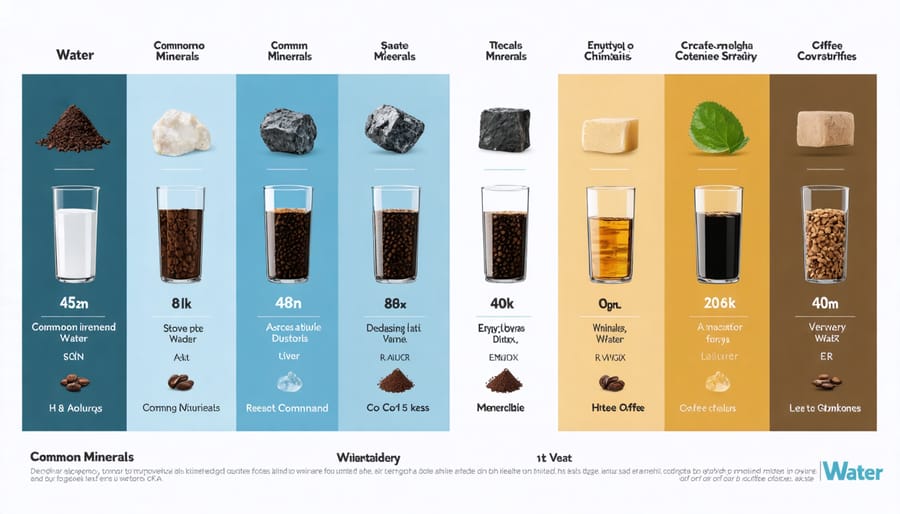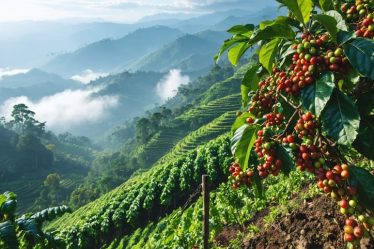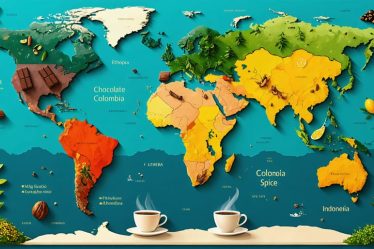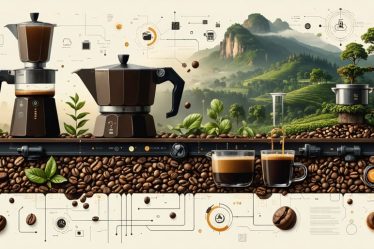
Ever wondered why your coffee tastes different at your friend’s house across town? The secret lies in your zip code’s unique water profile. Just like wine terroir affects grape flavor, your local water composition dramatically impacts barista-quality coffee brewing and everyday drinking water quality.
From mineral-rich mountain springs to chemically-treated city supplies, each neighborhood’s water tells its own story through distinct characteristics. These variations don’t just affect taste – they influence everything from your morning coffee’s bloom to the lifespan of your kitchen appliances.
Understanding your zip code’s water profile empowers you to make informed decisions about filtration needs, brewing techniques, and even which coffee beans will shine brightest in your cup. Whether you’re in a hard-water region that builds up scale or a soft-water area that might leave your coffee tasting flat, knowing your local water composition is the first step to crafting your perfect cup.
Let’s explore how your zip code’s unique water chemistry shapes your daily drinking experience, and discover simple ways to optimize it for better-tasting beverages and a healthier home.
Why Your Zip Code Matters for Coffee Brewing
Local Water Sources and Treatment
Ever wondered where your tap water comes from? As someone who’s lived in different regions across the country, I’ve noticed how water can taste completely different from one zip code to another. That’s because our water sources vary significantly depending on location.
Many urban areas rely on surface water from lakes, rivers, and reservoirs. These sources typically require more extensive treatment to remove sediments and potential contaminants. Meanwhile, rural communities often tap into groundwater through wells, which naturally filters through layers of soil and rock.
The treatment process your water undergoes depends on its source and your local infrastructure. Most municipal water systems use a multi-step approach that includes filtration, disinfection (usually with chlorine or chloramine), and pH adjustment. Some regions with harder water might add softening treatments, while others focus on removing specific minerals or contaminants unique to their area.
For example, in the Pacific Northwest, where I used to live, our crystal-clear water came from protected mountain reservoirs. Now in the Midwest, my water comes from deep groundwater wells and requires different treatment methods to make it safe and tasty for drinking.
Regional Water Differences
Have you ever noticed how coffee tastes different when you’re traveling? It’s not just your imagination! The water flowing through your tap varies significantly depending on where you live, and this directly impacts your morning brew. Just like different coffee flavor profiles can transport you around the world, your local water’s mineral content tells its own geographical story.
Living in areas with limestone-rich soil? Your water likely has higher calcium levels, creating a fuller-bodied cup of coffee. Coastal regions often have more sodium content, which can make your coffee taste slightly different than it would inland. Meanwhile, mountain regions typically enjoy naturally soft water with fewer minerals, resulting in brighter, more delicate coffee flavors.
I learned this firsthand when I moved from Seattle to Phoenix – my favorite coffee beans suddenly tasted completely different! This variation occurs because minerals like magnesium and calcium interact with coffee compounds differently, either enhancing or muting certain flavors in your cup. Understanding your local water composition is the first step to brewing your perfect cup of coffee at home.

Understanding Your Water Report
Key Minerals for Coffee Brewing
When I first started my coffee journey, I was surprised to learn that certain minerals in water can make or break your perfect cup. Let’s explore these coffee-friendly minerals and their ideal ranges – it’s simpler than you might think!
Calcium is your coffee’s best friend, ideally ranging between 50-100 mg/L. Think of it as the mineral that helps extract those rich, chocolatey notes from your beans. Together with magnesium (targeting 10-30 mg/L), these minerals create what coffee experts call “good hardness” – the sweet spot for flavor extraction.
Bicarbonate plays a fascinating role too, with an ideal range of 40-75 mg/L. Too much can make your coffee taste flat, while too little might leave you with an overly acidic brew. It’s like finding the perfect balance in a dance!
The total dissolved solids (TDS) should fall between 150-250 mg/L for optimal brewing. I love to think of TDS as the orchestra conductor, ensuring all minerals work harmoniously together. Speaking of harmony, your water’s pH should stay between 6.5-7.5 – neutral territory where coffee flavors truly shine.
A quick tip from my experience: if your tap water tastes great for drinking, it’s usually good for coffee too. But if you’re noticing your morning brew isn’t quite hitting the spot, these mineral ranges can help you understand why and guide you toward better coffee days.

Red Flags in Your Water Report
When reviewing your local water report, certain red flags can signal potential issues that might affect your coffee’s taste. Just like how my morning brew suddenly tasted off last year, these warning signs helped me identify the culprit in my water.
First, keep an eye out for high mineral content, especially calcium and magnesium levels above 150 parts per million (ppm). While these minerals can add body to your coffee, too much can lead to a chalky or bitter taste. Another common concern is chlorine levels – if you notice a strong pool-like smell in your tap water, it’s likely affecting your coffee’s flavor profile.
Pay attention to pH levels too. Ideally, your water should be slightly alkaline, around 7.0 to 8.0. If your report shows numbers outside this range, you might notice your coffee tasting either too sharp (acidic) or flat (alkaline). High sodium content is another red flag that can make your coffee taste oddly salty or flat.
Watch for seasonal variations in your water quality too. Many of us in the community have noticed that spring runoff or summer droughts can temporarily change our water’s composition. If you spot any of these issues in your report, don’t worry – there are several solutions available, from simple filtration systems to specialized coffee water treatments.
Remember, understanding these indicators is your first step toward consistently great-tasting coffee!
Solutions for Your Zip Code’s Water
Soft Water Solutions
Living with soft water can be a bit tricky when it comes to brewing that perfect cup of coffee, but I’ve discovered some amazing ways to make it work beautifully. Soft water typically contains fewer minerals, which might sound great at first, but it can actually leave your coffee tasting a bit flat or lacking in character.
The good news? There are several simple adjustments you can make to enhance your brewing experience. First, try slightly increasing your coffee-to-water ratio. I’ve found that using about 10% more coffee grounds helps compensate for the reduced mineral content and creates a more balanced flavor profile.
Another game-changer is using a mineral supplement designed specifically for coffee brewing. These supplements add back just the right amount of calcium and magnesium to create that sweet spot for extraction. Think of it as giving your water a little boost of coffee-friendly minerals!
Temperature control can also make a significant difference with soft water. Consider brewing at slightly lower temperatures, around 195°F instead of the usual 200°F, to prevent over-extraction. This small adjustment can help avoid any unwanted bitter notes that soft water might emphasize.
Don’t forget to clean your coffee maker regularly – soft water might be gentler on your equipment, but maintaining a clean brewing system is still essential for the best possible taste. A monthly cleaning routine should do the trick!
Hard Water Fixes
Living with hard water can be frustrating – I remember the first time I noticed those stubborn white spots on my glassware and wondered what was going on! Fortunately, there are several effective solutions to tackle hard water issues in your home.
The simplest fix is installing a water softener system. These systems use ion exchange to remove calcium and magnesium minerals that cause hardness. While the upfront cost might seem steep, many homeowners find the investment worthwhile for protecting their appliances and improving water quality throughout their home.
For a more budget-friendly approach, consider using a water filter pitcher or faucet-mounted filter specifically designed for hard water. These options work well for drinking and cooking water, though they won’t protect your pipes and appliances like a whole-house system would.
You can also try vinegar-based cleaning solutions for temporary relief from hard water buildup. A mixture of equal parts white vinegar and water can help remove mineral deposits from fixtures and appliances. For coffee lovers dealing with hard water, descaling your coffee maker regularly with vinegar or a commercial descaling solution is essential.
If you’re renting or not ready for a permanent solution, magnetic water conditioners offer a non-invasive option. While results vary, some users report softer-feeling water and reduced scale buildup after installation.
Remember, the best solution depends on your specific situation, budget, and water hardness levels. Start with water quality testing to determine the severity of your hard water before investing in any particular solution.
Filtration Options
When it comes to improving your water quality, I’ve found that choosing the right filtration system can make a world of difference in your daily life – and yes, even in your morning coffee routine! As someone who’s tried various options over the years, I’m excited to share the most effective filtration solutions that can help transform your tap water into something spectacular.
Carbon filters are perhaps the most common and budget-friendly option. These workhorses remove chlorine, sediment, and some heavy metals, making them perfect for basic filtration needs. I started with a simple Brita pitcher years ago, and it’s still a reliable choice for many households.
For those looking to step up their water quality game, reverse osmosis (RO) systems offer comprehensive filtration. While installing my RO system was a bit of an investment, it’s been a game-changer for both drinking water and as part of my essential coffee brewing equipment. These systems remove up to 99% of contaminants, including dissolved solids that can affect taste.
Ion exchange filters are particularly effective if you’re dealing with hard water. They swap out harsh minerals like calcium and magnesium for softer alternatives, resulting in better-tasting water and protecting your appliances from scale buildup.
UV purification systems offer additional peace of mind by targeting bacteria and viruses. While they don’t remove chemical contaminants, they’re excellent when paired with other filtration methods.
For those in apartments or rental properties, under-sink filters provide a great balance of effectiveness and convenience without requiring major plumbing modifications. I’ve found these particularly practical as they don’t take up counter space while still delivering high-quality filtered water.
Remember, the best filtration system for your home depends on your local water quality report and specific needs. Some of my readers have found that a combination of methods works best for their situation.

Knowledge is power when it comes to your drinking water quality, and now you have the tools to make informed decisions about the water flowing through your taps. Just as storing coffee properly is essential for the perfect brew, understanding and managing your water quality is crucial for your family’s well-being.
Remember, water quality can vary significantly even between neighboring zip codes, so don’t assume your experience matches your friend’s across town. Take the initiative to check your local water quality report, which is usually available through your municipality’s website or water utility provider. If you haven’t already, consider testing your home’s water using one of the methods we’ve discussed.
Whether you discover your water is perfectly safe to drink or needs some improvement, you’re now equipped with the knowledge to make the best choices for your household. From simple filtration solutions to more comprehensive treatment systems, there’s an option that fits your specific situation and budget.
I encourage you to share this information with your neighbors and become an advocate for clean water in your community. After all, water quality affects everyone, and together we can work towards ensuring safe, great-tasting water flows from every tap in our neighborhoods. Don’t wait – take that first step today and check your zip code’s water quality report!



